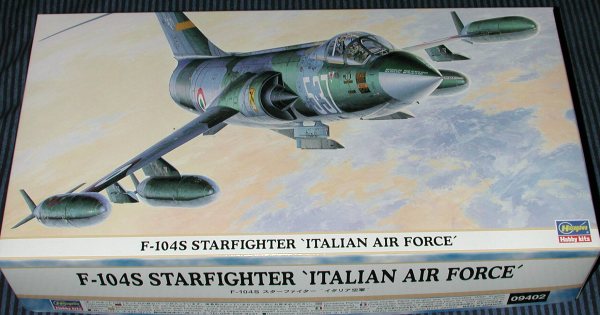
|
KIT: |
Hasegawa 1/48 F-104S Starfighter |
|
KIT # |
9402 |
|
PRICE: |
MSRP $29.98 |
|
DECALS: |
Three Aircraft |
|
REVIEW & |
|
|
NOTES: |
Don't be fooled by the box art |

|
HISTORY |
The F-104S is a modified F-104G built to Italian specifications. The AMI was looking to enhance both the air to air and ground attack capabilities of the F-104G so contracted with Lockheed to modify two Italian AF F-104Gs to 104S specs. This meant an improved radar as well as Sparrow capabilities in an under fuselage rack for the interceptor role and the addition of a 20mm Vulcan cannon and up to 7,500 lbs of ordnance on nine external hard points for the ground attack role. The engine was also uprated to 11,870 lbs of thrust (dry) and 17,900 lbs of thrust (afterburner). External clues are the addition of ventral fins either side of the rear fuselage and a blow in door on the side of the intakes for additional air during ground operation.
246 F-104S Starfighters were built by Fiat between December 1968 and March 1979, examples also going to the Turkish Air Force. All Italian F-104S versions were upgraded to 104S ASA starting in December 1984 and feature improved avionics systems. On some aircraft, the gun was deleted. As of this writing, the type is still in service.
|
THE KIT |
I'm going to wimp out and refer you to Andy Abshier's review of the F-104J for all the basics on the kit, only putting in my two cents worth on the differences. This is the fourth version to be released by Hasegawa, following the J, C and G versions. This is the first of the series that I have bought so have no first hand knowledge of the other three.
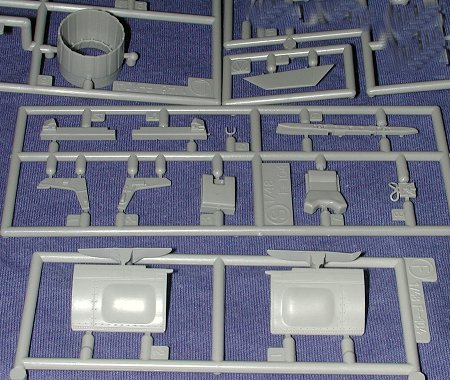 Compared to the J, there are only
a few bits that are different, and some may also be in the C or G kit. All of
them are shown to the right. Starting at the top left and going to the right,
there is a new exhaust nozzle, and new ventral strakes (only one shown,
there are two). Below that is a different bang seat and a centerline hard point
(though nothing to put on it). Just under that (and yes, that is flash you see),
are the bulged gear doors. Completely missing from the kit and shown on the box
art, are any wing pylons or extra fuel tanks. Also missing are the missile
launch rails for under the fuselage.
Compared to the J, there are only
a few bits that are different, and some may also be in the C or G kit. All of
them are shown to the right. Starting at the top left and going to the right,
there is a new exhaust nozzle, and new ventral strakes (only one shown,
there are two). Below that is a different bang seat and a centerline hard point
(though nothing to put on it). Just under that (and yes, that is flash you see),
are the bulged gear doors. Completely missing from the kit and shown on the box
art, are any wing pylons or extra fuel tanks. Also missing are the missile
launch rails for under the fuselage.
Now I don't know about you, but I feel rather ripped off by the omission of these parts as they are much of what makes the F-104S what it is. Especially as these items are shown on the box art! In other words, you could just as easily build this as a late F-104G (that is assuming that the seat and exhaust are the same) by not putting on the extra ventral fins, and no one would be the wiser. Two thumbs down to Hasegawa for pulling this stunt on us.
Getting over my disappointment, I'll echo Andy Abshier's comments about the detailing and quality of the mold. However, I'm going to mention that this kit has quite a few parts that have ejector pin marks on them. For instance, you will find them on the inside of the gear doors as well as on the separate flaps, slats and ailerons. They are also on the wheels, the rudder and the landing gear struts. None will be easy to remove as they are close to detail on these parts. The images below show what I mean.
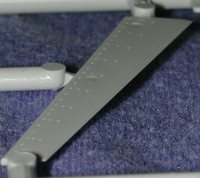 |
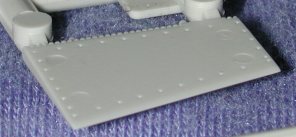 |
 |
As you can imagine, the instructions are very well done as one comes to expect
from Hasegawa. They haven't changed their format in 15 or more years and there
is no real reason to do so. There are markings for three aircraft, all of them
in NATO Green and Grey over Silver. Hasegawa would have you do the upper colors
in RLM 71 and US Neutral Grey, which I guess is
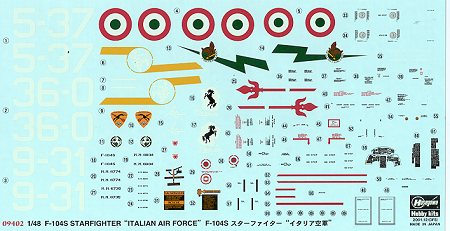 a pretty close match. The only
difference between the planes are the unit codes and markings. However, the
early F-104S was a pretty colorful aircraft. Later the unit colors were
downsized or removed as were the insignia and codes. Even later they went the
shades of grey route when the planes were converted to ASA variants.
a pretty close match. The only
difference between the planes are the unit codes and markings. However, the
early F-104S was a pretty colorful aircraft. Later the unit colors were
downsized or removed as were the insignia and codes. Even later they went the
shades of grey route when the planes were converted to ASA variants.
Basically the three units are 5 Stormo with yellow tail markings as shown on the box art, 36 Stormo with a green lightning bolt in the tail markings and 9 Stormo with a red trident just behind the intake. Decals are standard Hasegawa with the white a bit on the cream side and they also look to be a bit transparent, but this is typical of Hasegawa's kit decals. Personally, I'll be using aftermarket ones if I can find some I like.
|
CONCLUSIONS |
Well, it is really a bit hard to cover my initial disappointment. I was really expecting a very nice F-104S with all the proper goodies, but the lack of pylons sort of takes some of the eager anticipation out of things. Not really thrilled about trying to fill in the ejector pin marks on the control surfaces and landing gear, either. I'm sure the kit will sell very well, and I'm equally sure that I'll enjoy constructing the kit once I get started. However, if you are looking for the ultimate Starfighter, I guess you'll just have to wait until Hasegawa gets off its duff and does a 'special edition' that includes resin or metal pylons at a $20 increase in the kit price.
|
REFERENCES |
Lockheed Aircraft since 1913, Naval Institute Press, 1987
Review kit courtesy of my kit collection.
If you would like your product reviewed fairly and quickly by a site that has over 100,000 visits a month, please contact me or see other details in the Note to Contributors.